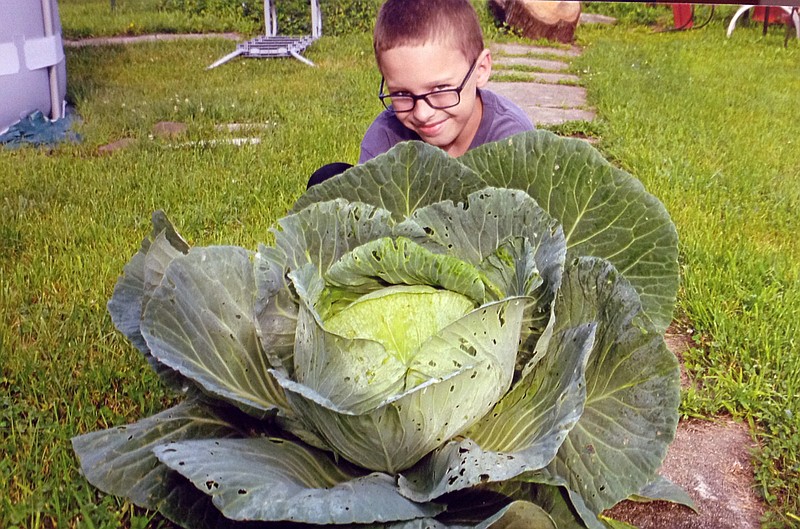Nine-year-old McIntire Elementary School student Ayden Potts may not be a "Cabbage Patch Kid," but he knows how to grow a cabbage that's the size of an infant - one that weighed 8.4 pounds.
Ayden's grandma, Patty Potts, helped her grandson grow the colossal cabbage as part of Bonnie Plants' Third Grade Cabbage Growing Program.
"It got so big we had to enlarge the fence," Potts said, describing the cabbage plant. "We had to make it bigger around because the leaves came outside the 22-inch pot."
Potts said when Ayden returns to school this fall, he will submit a picture of him with his cabbage along with its weight to his third grade teacher, who registered the class for the program. His teacher will pick a winner from the class' cabbage entries, and that student will be eligible for a chance to win a $1,000 scholarship from Bonnie Plants for the best cabbage in Missouri. Each state's director of agriculture selects the best in-state cabbage by a random drawing.
"I had two raised beds, and we were gonna put it in one of the raised beds but then we were concerned that the deer, the groundhogs, the whatnot would eat it," Potts said. "That's why we decided to put it in a 22-inch pot and then let it grow. We saw something was nibbling on it, so we put a fence around it so it wouldn't get eaten."
Potts said while her and Ayden were sitting by the pool outside, they saw what appeared to be two white butterflies hovering near the growing cabbage.
"I said, "Oh, look at the butterflies!' But what they were, were laying eggs for cabbage worms," she said. "And over the next couple of days, those holes started getting in the cabbage plants, so we just sprinkled a little bit of sevin dust on it."
The sevin helped deter whatever pesky insect was sabotaging the cabbage plant's leaves.
"They (the insects) were over there all day long," Potts said. "We read up on it and every time one of those - what we thought were butterflies - landed on the plant, it was laying an egg."
Potts said Ayden brought the plant home near the end of the school year and they transplanted it within a week.
Bonnie Plant's student growing guide suggested to feed the plant with Bonnie Herb and Vegetable Plant Food, or another all-purpose fertilizer, but Potts said she didn't feel the need to buy cabbage food. Instead, they simply used garden soil for fruit and vegetables, which contains essential plant-growing nutrients.
"In the beginning we also put a big clear plastic jar - like what those great big cheese balls come in - to kind of incubate it because I thought that it would help the root system," Potts said.
Placing the jar over the plant created a "terrarium-type atmosphere where the water would not even evaporate but get on to the sides of the jar and then it would drip back down onto the plant," she said.
She thought that the extra step would help the plant take root better and grow faster, giving it a head start.
Potts said she learned the method from her grandma, who use to clip roses.
"She would take a rose, she would stick it down in the ground, and she would put a mason jar over it and kind of incubate it, so that it would take root and protect it until it grew so big and she had to take the jar off," Potts explained.
She said that she and Ayden never had to water the plant because of all the rain Missouri's had this summer.
Potts could tell when the cabbage had finished growing by the way the plant's leaves changed.
"You could look down into the cabbage and you could just see the head," Potts described. "As it starts to grow, there's darker leaves that are on the top and then whenever the cabbage got so big, then you could see the lighter green cabbage leaves. The dark wasn't covering the head anymore, so I thought, "Well, must be time to pick it.'"
Potts said as large as the plant was at harvest time July 23, she was surprised that it only weighed 8.4 pounds.
"As big as that plant is, and when we picked the leaves off, I was thinking, "Oh my gosh - I bet this thing's gonna weigh 22 pounds!'" she said.
When they were harvesting it, Potts asked her grandson what he wanted to do with the colossal cabbage.
"He said, "I want to give it to people who need it'", Potts said.
Potts said they weighed the cabbage with leaves intact after they harvested it in the morning. When Ayden returned home that evening, they chopped off the plant's gigantic leaves with a meat cleaver and discarded them in a compost pile.
The next day, Potts, Ayden and his classmate and friend, Brooke Garrett, took the cleaned up cabbage to the Fulton Soup Kitchen as a donation.
Potts said she is unsure if Ayden has talked to any of his classmates about the size of their cabbages, but she is excited to find out how his classmates' cabbages turned out once school starts.
Potts said her grandson is proud of his cabbage and would never act boastful about his accomplishment.
"He's a humble soul," she said. "He would never go around and tell people, ""Oh, I grew a big cabbage and I donated it to the soup kitchen!' He's a humble little boy and a sensitive little person. He has such empathy for animals and the plight of other people."
The Third Grade Cabbage Growing Program started in 2002 with the goal of educating children about agriculture, responsibility and the basics of gardening. Since the program was implemented, Bonnie Plants has donated more than one million cabbages to third grade classrooms participating in the program across the country each year.

